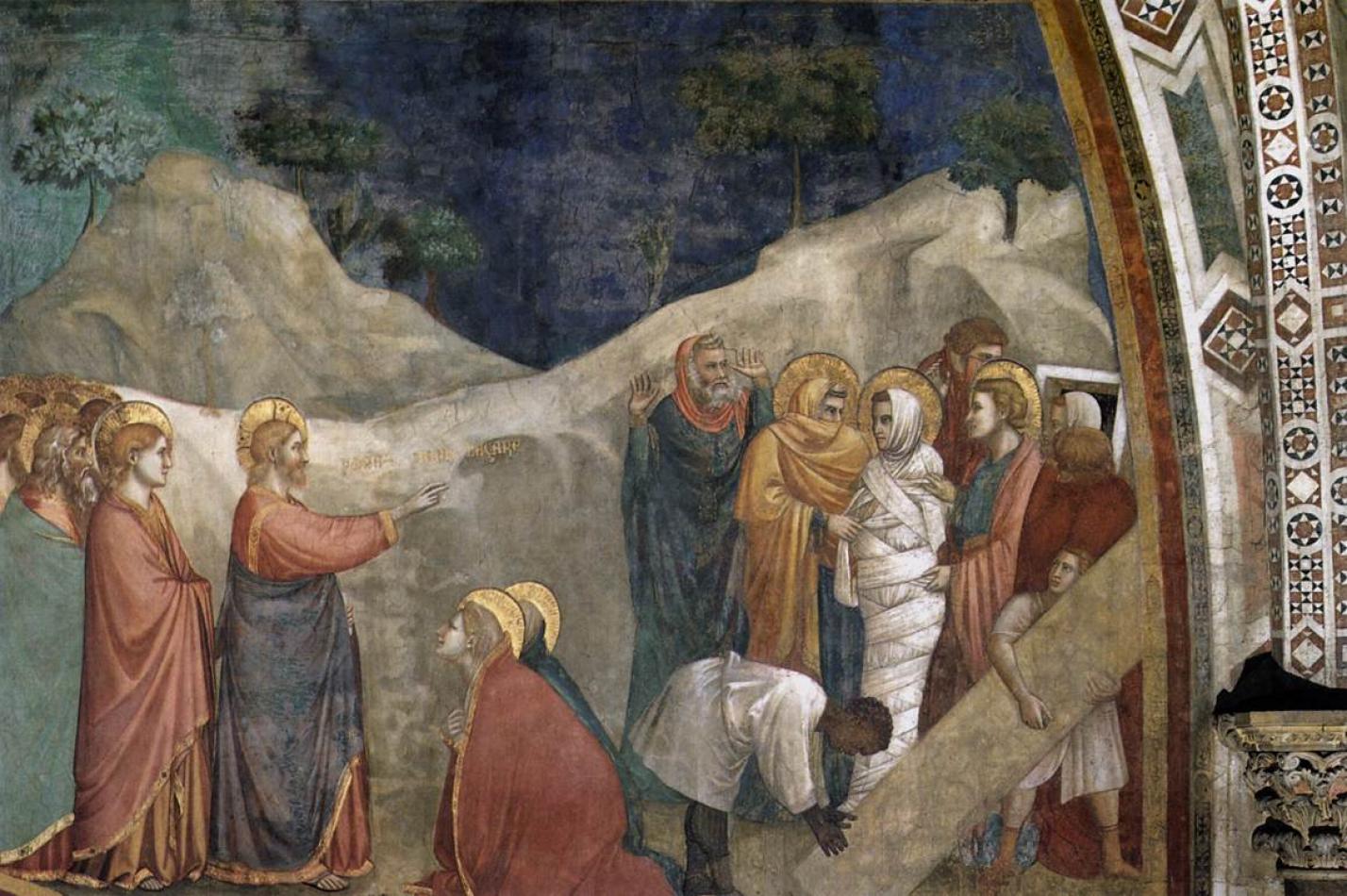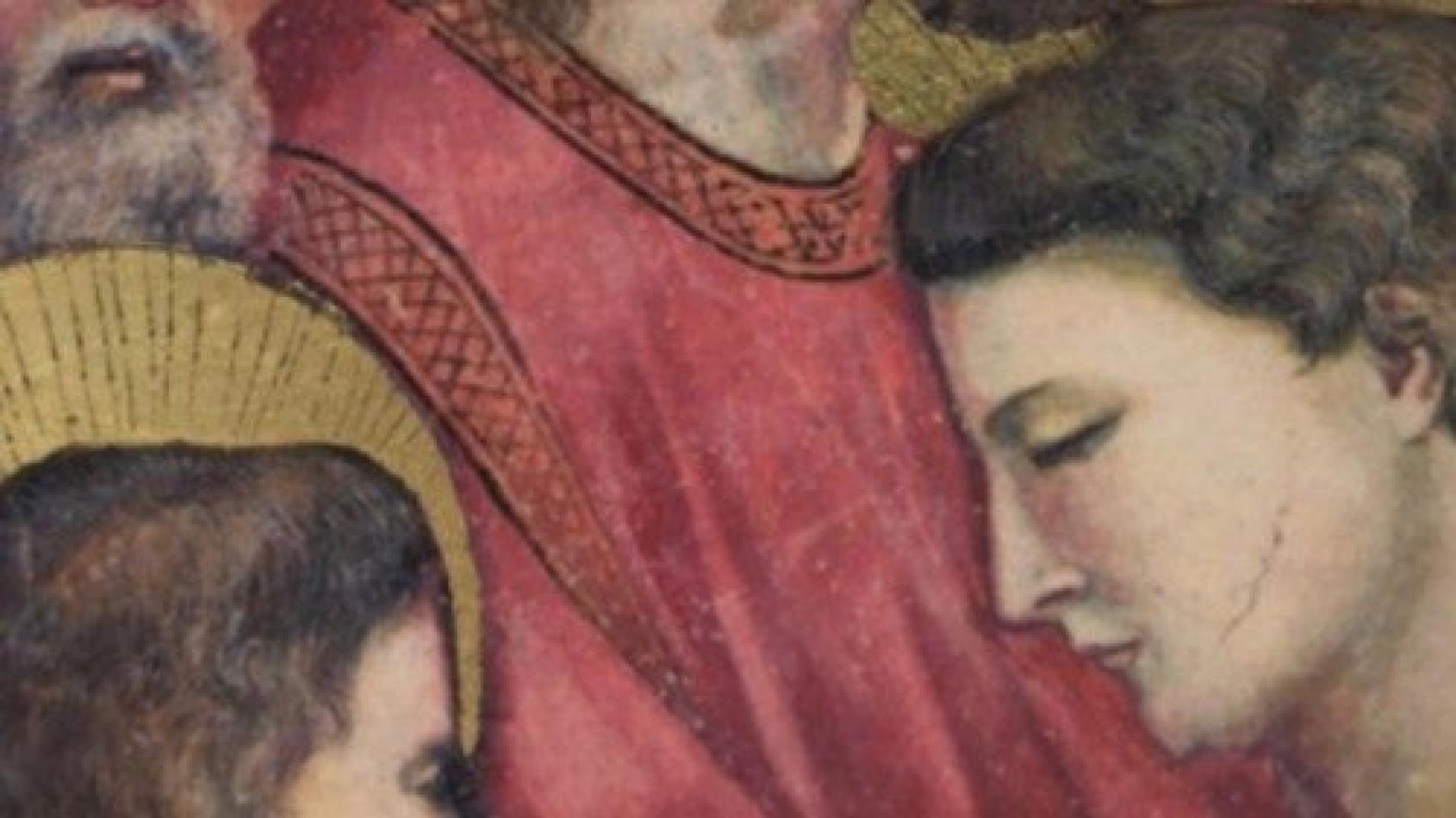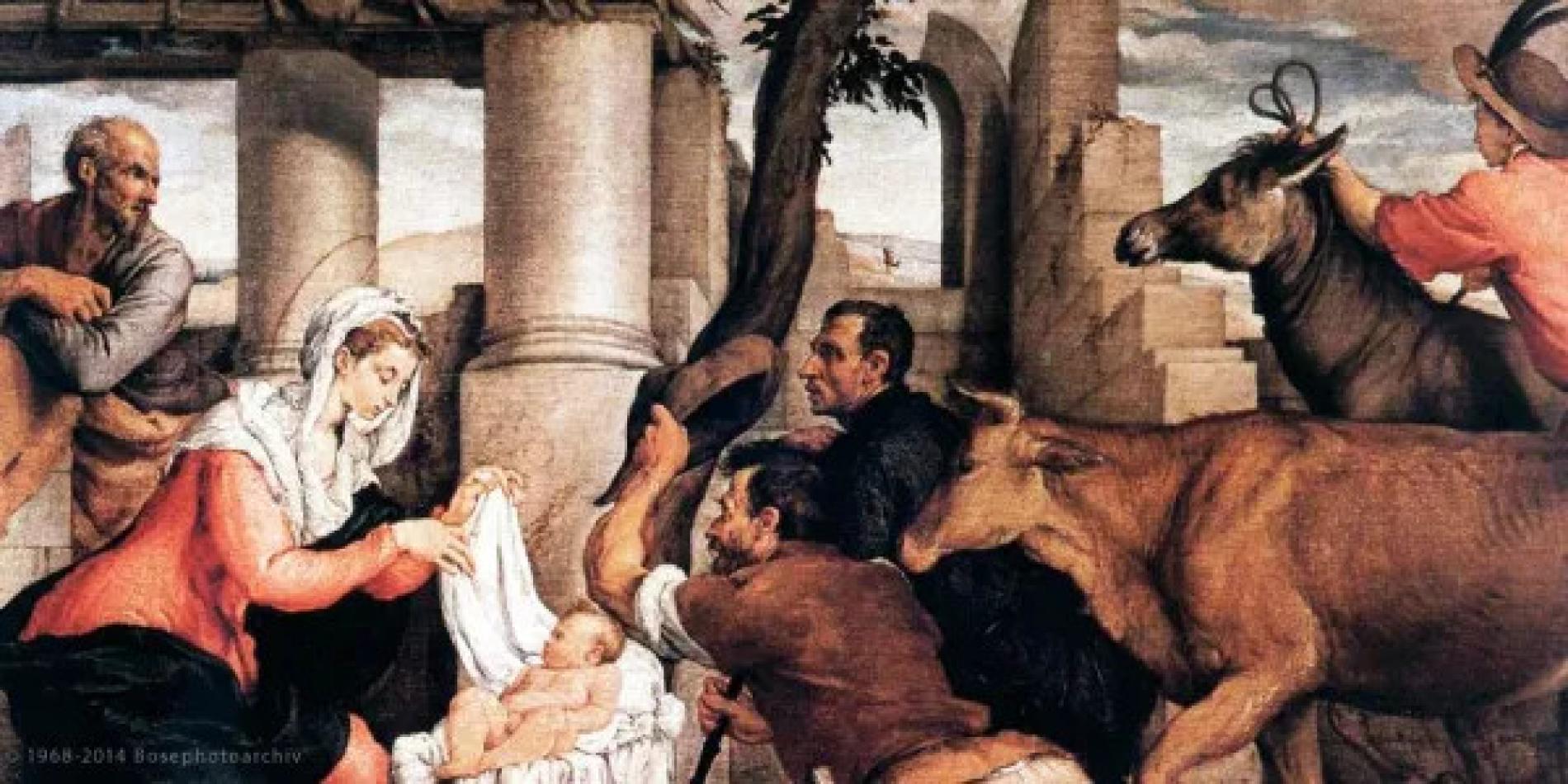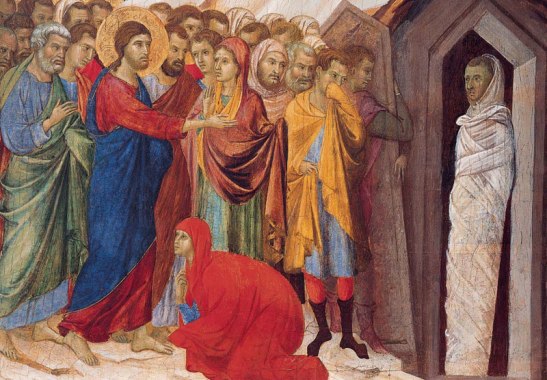Daniel Comboni
Comboni Missionaries
Institutional area
Other links
Newsletter
The story of Lazarus’ resuscitation is very long but the part dedicated to the miracle is very short, only two verses (vv. 43-44). The rest consists of a series of dialogues that aims to lead the reader into a deeper level of the text where the true meaning of the sign performed by Jesus can be captured. (...)
The Tomb: A Womb, No Longer A Grave
John 11:1-45
The story of Lazarus’ resuscitation is very long but the part dedicated to the miracle is very short, only two verses (vv. 43-44). The rest consists of a series of dialogues that aims to lead the reader into a deeper level of the text where the true meaning of the sign performed by Jesus can be captured.
I mentioned the resuscitation of Lazarus, not his resurrection because to return to this world, to restore this material life, is still marked by death. To leave this life definitively, as it happened to Jesus on Easter, to be introduced in the world of God where death, any kind of death, has no more access, is another thing. Going back to this material world is to resuscitate but to go beyond this material world, into the world of God, is to resurrect.
Having clarified this, let us approach the passage. If Lazarus’ death appeared in a newspaper where fidelity to facts is strict, we can detect some inconsistencies and some unlikely details because this is not a historical fact but a page of theology. In the Gospel of John, there constitutes precious indexes that guide us toward the theological message of the story. I will try to enumerate them:
– In the first verses (1-3), a rather strange family appears. There are no parents, no mention of husbands, wives, children, but only a brother with two sisters.
– In verse 6 an inexplicable behavior of Jesus is reported: He is aware that Lazarus is sick, and instead of healing him immediately, he stays for two more days. It seems that he wants him to die. Why doesn’t he intervene?
– Shortly after making a puzzling statement: “Lazarus is dead and I’m glad I was not there” (v. 15), how can he rejoice of not having prevented the death of his friend?
– Another difficulty: at that time there were no telephones; how did Martha hear that Jesus was coming (v. 17)? And, while she goes to call Mary (v. 28) what does Jesus do while still on the road? Why wait for Mary to come out from Bethany, and go to him? We would not have behaved in this way: we would have proceeded directly to the house of the deceased to give our condolences.
In vv. 25-26, we are faced with a statement of Jesus which is difficult to interpret: “Whoever believes in me, though he dies, shall live. Whoever lives and believes in me will never die.” How can he promise that his disciple will never die when we realize that Christians die like everyone else? What does he mean?
In verse 35, it is said that Jesus weeps over the death of his friend. How could he when he already knows that he will resurrect him? Is he pretending?
– Finally, the family of Bethany disappears without leaving any trace in the Gospel of John and does not appear anymore throughout the New Testament. What happened to these three people so dear to Jesus?
It’s strange that such a striking miracle is not mentioned by the other evangelists. These details are certainly signs that John wanted to offer his readers not a cold account of facts but a dense piece of theology. Taking a cue from a healing that had aroused quite an impression because the sick was presumed dead, the evangelist has addressed the central theme of the Christian message: Jesus, the Risen One, is the Lord of life.
Let’s start with the meaning that John intends to give to the family of Bethany, consisting only of a brother and sisters. It represents the Christian community where there are no superiors and inferiors but only brothers and sisters. An intense affective atmosphere unites these people to Jesus. The evangelist places considerable emphasis on the friendship between the Master and Lazarus (vv. 3,5,11,36). It’s the symbol of the deep bond between Jesus and every disciple: “I do not call you servants—he will tell at the Last Supper—but I have called you friends” (Jn 15:15).
In this community, a case that rattles happens. It confronts an insoluble enigma: the death of a brother. What is Jesus’ answer to the disciple who asked him if this tragic event may have a meaning? Whoever loves a good friend will not let him die. If he was a friend of Lazarus and ours, why doesn’t he prevent death?
Like Mary and Martha, we also do not understand why he “let two days go by.” As a sign of affection for the friend, we would have expected him to intervene immediately. The veiled complaint made by the two sisters could also be ours: “If you had been here, Lord, our brother would not have died” (vv. 21,32). The death of a loved one, our death, puts faith to a test. It gives rise to the suspicion that he is “not here,” that he does not accompany us with his love.
By allowing Lazarus to die, Jesus responds to these questions: it is not his intention to prevent biological death. He does not want to interfere in the natural course of life. He has not come to make this form of life eternal but to introduce us to that which has no end. The life in this world is destined to end, and it is good that it should be so.
In this perspective, we should reconsider the validity of the relationship that many Christians have established with Christ and religion. When this is reduced to the pressing demands of miracles, it inevitably results in a crisis of faith and the doubt that “he is not here” where we would expect him to be, where we need him most, in sickness, sorrow, and misfortune.
The dialogue with the disciples (vv. 7-16) aids the evangelist to express our uncertainties and fears in the face of death. It is the reaction of humans who fear that death marks the end of everything.
Fear is the most insidious enemy of the disciple. Whoever fears death cannot live as a Christian. To be a disciple means to accept losing one’s life, to give it for love, dying like the grain of wheat that falls to the earth and produces much fruit (Jn 12:24-28).
In the words of Jesus, death is presented in its proper perspective. He claims to be happy not to have prevented his friend Lazarus from dying (v. 15) because for him death is not a destructive, irreparable event but marks the beginning of a condition infinitely better than the last.
We thus come to the central part of the passage, the dialogue with Martha (vv. 17-27).
Lazarus has already been in the tomb for four days. At that time, it was believed that during the first three days the person was not yet completely dead. Life would permanently leave him only on the fourth day. John does not want to inform us of the exact date of Lazarus’ death. He only wants us to know that Lazarus was dead and nothing more. It is the necessary premise to the question he wants to answer: What can Jesus do for one who is completely dead?
In the dialogue that follows, Jesus leads Martha to understand what the significance of the death of a disciple (a brother or a sister of the Christian community) has.
“If you had been here” is a human proclamation of surrender in front of an event that surpasses him, which makes a mockery of his efforts to dismiss it. Death also leads us to doubt God’s presence. If God exists, why is there death?
Martha belongs to the group of those who, unlike the Sadducees, believe in the resurrection of the dead. She is convinced that, at the end of the world, her brother Lazarus will return to life together with all the righteous and will take part in the Kingdom of God.
This is her way of understanding the resurrection (perhaps similar to that of many Christians today) that does not console anyone. It’s too far away and does not make any sense. Why would God let one die only to bring him back to life again? Why make one wait that long? How can the soul be without the body? Finally, a similar resurrection is less credible. If a person dies, God can certainly recreate him, but, in such a case, it would be a clone, not the same person as before.
The Christian does not believe in a death and a resurrection that will take place at the end of the world. He believes that the person redeemed by Christ does not die.
Let us try to understand this new and extraordinary message that Jesus announces to Martha. He says: “Whoever believes in me will never die” (v. 26). What does this mean? How can a person that we see expire and becomes a corpse not die? To explain this there is a need to resort to comparisons.
Our whole existence is characterized by exits and entrances. We go out from nowhere and enter into the womb of our mother. Once gestation is completed, we leave to enter this world characterized by many signs of death. Loneliness, abandonment, distance, betrayal, ignorance, disease, and pain are forms of death. Our life here is never complete. It is always subject to limitations. This cannot be the final world, our ultimate destiny. To live fully and without death, we must get out of it.
Let us suppose that in the womb of a mother there are twins. They can see, understand, and speak to each other during the nine months of gestation. They only know their own little world and cannot imagine what life is like outside. They do not know that people marry, work, and travel. They have no idea that there are animals, plants, flowers, beaches. The only thing they know is the kind of life they have inside the womb.
After nine months, the twins are born by turn. And the one who was born a few seconds later and remained, even for a short time, in the womb of the mother, would certainly think: “My brother is dead. He’s not here anymore. He disappeared and left me …” and he cries. But the brother is not dead. He only left a restricted, short, limited life and went into another form of life.
The disciple—Jesus says to Martha—does not experience death at all but is born to a new form of life. He enters the world of God, takes part in a life that is no longer subject to limits and death, as it happens on earth. It is a life without end. We cannot say more because, if we describe it, we would just be projecting the forms of this life. It remains a surprise and God keeps it to himself: “Eye has not seen, ear has not heard, nor has it dawned on the mind what God has prepared for those who love him” (1 Cor 2:9).
In the Christian perspective, therefore, life in this world is a gestation, and death is verified by one who remains, not by one who dies.
At this point, we can understand why Jesus is pleased with not having prevented the death of Lazarus. He sees it in God’s sight: as the most important and the happiest moment for a human being. Rightly, the early Christians called it the “day of birth” what other people called the fateful day in which they plunge into nothingness.
The judgment of Lao-Tze is known: “That which for the caterpillar is the end of the world, for the rest of the world is a butterfly.” The caterpillar does not die; it disappears as a caterpillar but continues to live as a butterfly. It’s another image that helps us to understand the victory of Christ over death.
After listening to the words of Jesus, Martha pronounces a significant profession of faith. She acknowledges that Jesus is the one who gives this life: “Yes, Lord, I have come to believe that you are the Christ, the Son of God, he who is coming into the world” (v. 27).
We will not dwell on the dialogue between Jesus and Mary (vv. 28-33) because it adds nothing to what has already been said. We only note that Jesus does not enter into Bethany, where the Jews went to console the sisters. He does not go to extend condolences but to give life. He wants also that Mary leaves the house where everyone is crying. His quiver— “he was moved and troubled”—also shows how he feels deeply, like any person, the drama of death.
The final scene is important (vv. 34-42).
It opens with the weeping of Jesus. The Christian cannot say so if he does not believe that death is none other than a birth. However, he is not insensitive and sheds tears when a friend leaves him. He knows that he is not dead and is happy that he is living with God. However, he is sad because, for a time, he will have to be separated from him.
There are but two ways of weeping. One that is inconsolable and undignified of someone who is convinced that, with death, it’s all over. The other is that of Jesus who, in front of the tomb, cannot hold back the tears. These two forms of crying are expressed in the Greek text with two different verbs. For Mary, Martha, and the Jews klaiein (v. 33) is used. It indicates that the crying is accompanied by gestures of despair. With Jesus, it is edakrusen, which means “tears began trickling from his eyes” (v. 35). Only this serene and dignified weeping is Christian.
Weeping is followed by an order: “Take away the stone!” It is addressed to the Christian community and all those who still think the world of the dead is separated and has no communication with that of the living. Anyone who believes in the Risen Lord knows that all are alive, even though they are partakers of two different forms of life. All barriers have been torn down; all the stones have been removed on the day of Easter; now one goes from one world to another without dying.
The prayer that Jesus addressed to the Father (vv. 41-42) is not a request for a miracle, but a light for the people around him. He asks that everyone may understand the deep meaning of the sign that he is going to do and that they come to believe in him, the Lord of life.
The cry, “Lazarus, come out!” is the fulfillment of his prophecy: “Truly, the hour is coming when the dead will hear the voice of the Son of God and on hearing it, will live. All those lying in the tomb will hear his voice and come out” (Jn 5:25-29). In fact, “the dead,” with all the signs that characterize his condition, “his hands and feet were bound with linen strips, and his face wrapped in a cloth” (v. 44), comes out. “The Dead”—says the text. Yes, because it is with the dead, with one who remains definitely dead (four days in the tomb) that Jesus shows his vivifying power: not bringing him back to life on earth (this would be a short-lived victory, not definitely to death), but bringing it with him in the glory of God.
Untie him and let him go” (v. 44)—he finally orders. The invitation is addressed to the brothers and sisters of the community who mourn the loss of a loved one. Let the “dead” live happily in his new condition. The seer of Revelation describes it with striking images: “God will wipe away every tear from their eyes. There shall be no more death or mourning, crying out in pain for the world that was, has passed away” (Rev 21:4).
There are many ways to try to retain the deceased: obsessive visits to the cemetery (which is like searching the living among the dead), the morbid attachment to personal effects, and recourse to mediums for establishing contacts. It is painful to be left by a friend, but it is selfish to want to hold on to him. It would be like preventing a child to be born. “Untie, let him go”—Jesus sweetly repeats today to every disciple who does not resign himself to the death of a brother or a sister.
Fernando Armellini
Italian missionary and biblical scholar
https://sundaycommentaries.wordpress.com





